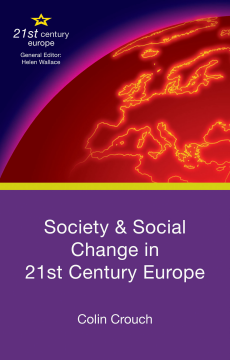
Additional Information
Book Details
Abstract
Ranging from some of the most advanced economies in the world to others with only modest national income, and from well established democracies to countries with lengthy histories as dictatorships, Europe presents the social scientist with a laboratory of different social forms. Colin Crouch here draws on 40 years experience as a researcher on European societies to explore this diversity across such key areas of life as patterns of birth and death, family, gender, migration, religion, work, economy and inequality.
This accessible book is written with students on courses in sociology and political science, and also general readers, in mind. However, it also marks an original contribution to the study of European societies by presenting a new approach to study of social class in post-industrial societies, and by bringing together knowledge of all parts of Europe, including those in the east.
"Colin Crouch is, as ever, the supreme guide through the complexities of social life in the societies in which we now live. This is obligatory reading for all who wish to make sense of the social world around us." - Colin Hay, Sciences Po, Paris, France
'This is a major contribution to our understanding of European societies from one of Europe's foremost scholars. An exemplary combination of contemporary quantitative analysis and deep historical understanding, it convincingly challenges conventional accounts and represents a model of comparative analysis. This will assuredly be a landmark of comparative social science.' – Anthony Heath, Nuffield College, University of Oxford, UK
Colin Crouch is Professor Emeritus of the University of Warwick, UK, external scientific member of the Max Planck Institute for the Study of Societies in Cologne, Germany, and Vice-President for social sciences of the British Academy.
Table of Contents
| Section Title | Page | Action | Price |
|---|---|---|---|
| Cover | Cover | ||
| Contents | vii | ||
| List of Illustrative Material | ix | ||
| List of Abbreviations | xiii | ||
| Acknowledgements | xv | ||
| Foreword | xvi | ||
| 1 Is there a European society? | 1 | ||
| Europe’s debatable boundaries | 8 | ||
| Identifying sub-regions of Europe | 12 | ||
| Conclusion | 25 | ||
| 2 The people of Europe | 28 | ||
| Life expectancy | 30 | ||
| Birth rates | 34 | ||
| Death rates | 40 | ||
| Immigration and overall changes in population size | 40 | ||
| Marriage and family | 46 | ||
| Conclusion | 55 | ||
| 3 Identities: religion and ethnicity | 57 | ||
| European religion | 61 | ||
| Ethnicity, immigration and cultural diversity | 77 | ||
| Conclusion | 86 | ||
| 4 Europeans at work | 88 | ||
| Employment sectors organized by type of product | 88 | ||
| Types of occupation | 105 | ||
| Conclusion | 118 | ||
| 5 From occupations to classes | 121 | ||
| Occupations, income and social class | 124 | ||
| Income inequality, taxation, transfers and public services | 129 | ||
| Conclusion | 145 | ||
| 6 Delineating the class structures of contemporary Europe | 147 | ||
| Class and citizenship | 152 | ||
| Classes and power | 155 | ||
| Conclusion | 167 | ||
| 7 The wider implications of class | 170 | ||
| Education and social mobility | 171 | ||
| Health and life expectancy | 178 | ||
| Class and political identity | 181 | ||
| Conclusion | 189 | ||
| 8 How many Europes? | 190 | ||
| Norden | 193 | ||
| South-West Europe | 195 | ||
| Central Eastern Europe | 197 | ||
| Further Eastern Europe | 198 | ||
| North-West Europe | 200 | ||
| The anglophones | 201 | ||
| Conclusion | 203 | ||
| Statistical Appendix | 209 | ||
| References | 218 | ||
| Index | 223 |
